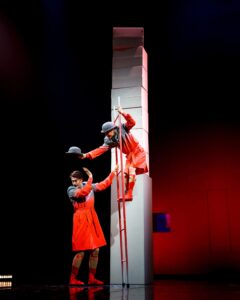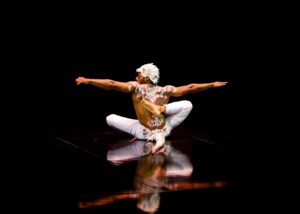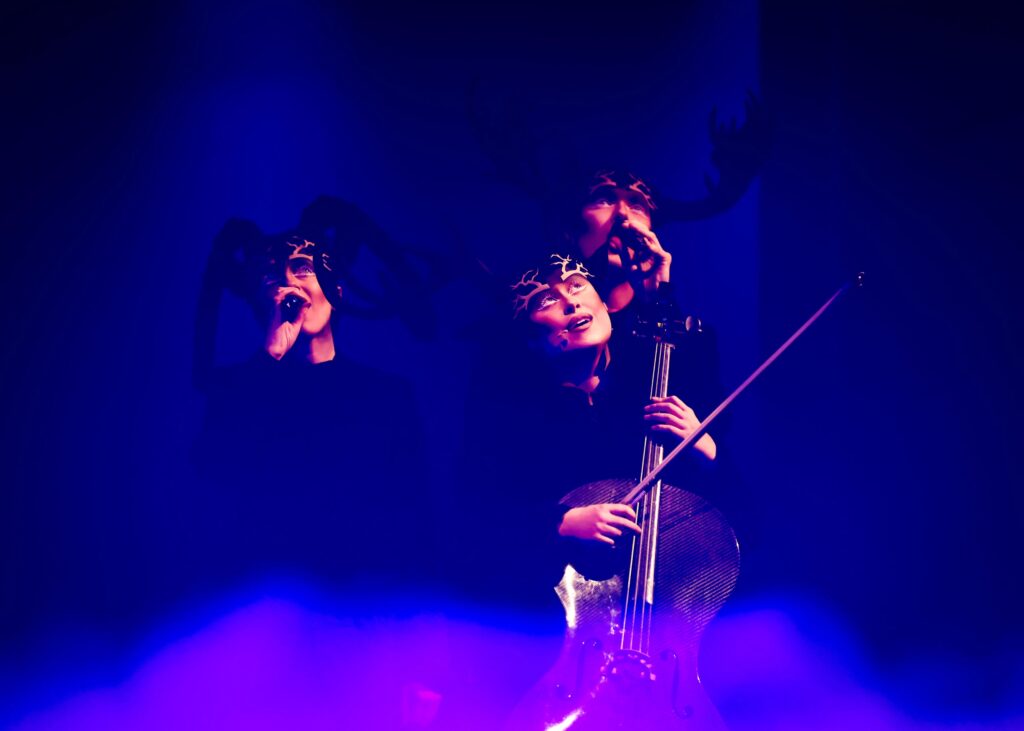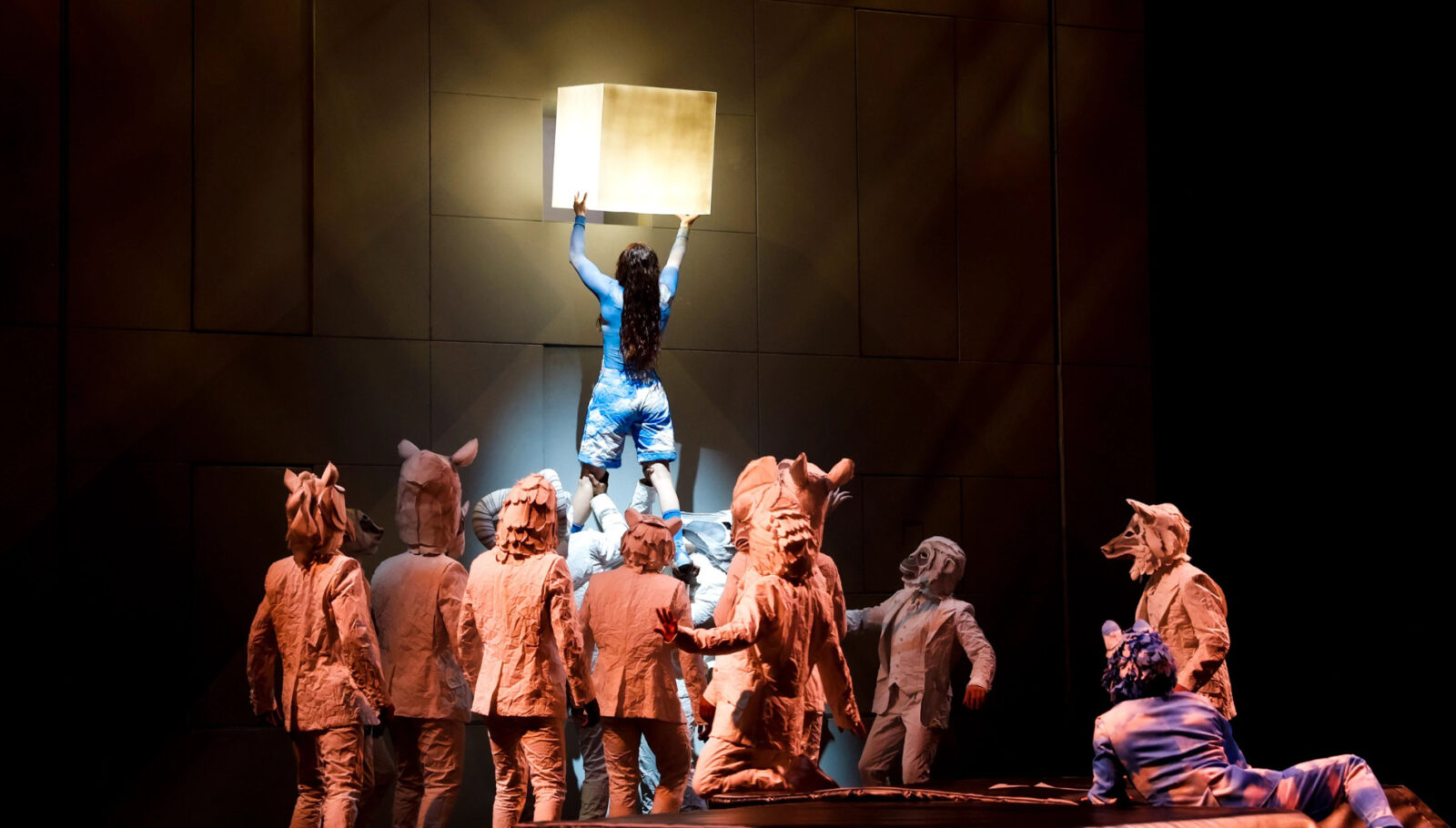Cirque du Soleil’s ECHO: Where Small Actions on Stage Have Big Effect
To step into a blue-and-white striped circus tent pitched on a concrete lot surrounded by tall office buildings and the local high-end shopping mall is to be pulled out of suburban life and into the clean, blank canvas of imagination. That was my first thought as I entered the scene of Cirque du Soleil’s Echo with my family on the night of October 21, 2023. When the world-famous company chose my hometown of Tyson’s Corner, Virginia, as the site for Echo to make its United States debut, I knew I had to see it—and getting to edit Pascal Jacob’s lovely review only made me more excited to meet the famous Cube up-close and personal (if hesitant as to what more I could add to the discussion after a circus legend had already given his thoughts). Suffice it to say, Echo did not disappoint.
Cirque du Soleil’s official online write-up of Echo describes it as “a tale about evolution as well as the symbiotic relationships that our lives depend on.” This environmentalist angle is apparent in both press materials and in its sound, set design, and costuming, which often evoke the feeling of nature as artifice. That said, one would be hard-pressed to try and recount the “tale” of Echo in the same order that it plays out on stage. As with most contemporary circus, its storytelling method is wholly physical, and often indirect; in fact, the most clearly articulated story beat might be the four-minute prologue film found in the show’s mobile-optimized Interactive Program, although my poor old Android phone did not let me view it while at the venue. Nonetheless, the film contextualizes the show’s worldview and major characters in such a way that I would recommend it to anyone who, like myself, likes to construct a concrete story in their head while watching something.

But just by sitting there in the stands, the audience of Echo is made witness to a series of amazing feats done by mankind and nature, as seen through the eyes of the show’s head-in-the-clouds protagonist Future (Louana Seclet-Monchot) and her best friend Ewai the Dog (Philippe Dupuis). Accompanied by an antler-wearing, black-clad band whose soothing, earthy sound could give Enya a run for her money, Echo’s world is quickly populated by a jungle of white animals that perform tricks and tease the audience; ensembles of human acrobats in color-dipped white jackets; the Double Trouble duo (Clement Malin and Caio Sorana), two clownish types in gray-and-scarlet suits who somehow turn the act of stacking cardboard boxes into a legitimate exercise in suspense; and jaw-dropping, show-stopping contraptions like a massive marionette built from a rainbow of painted metal. And always in the background is the show’s most prominent supporting character: the Cube itself.

Pascal Jacob did not exaggerate the Cube’s importance—Cirque du Soleil’s designers deploy this shape in ways that would make any geometry teacher proud, maybe even envious. They did not think outside the box so much as they thought inside, beside, and through it. On its own, a giant white square evokes the concrete monoliths you see in any urban area, but when it’s used as a surface to project images of rolling waves and leafy branches, it reminds you that nature is far less removed from us than it often seems. You can hear oohs and aahs from all around the tent when the show’s talented cast uses the cube as an apparatus for the “vertical ballet” by dangling from the top and dancing off the sides (while wearing animal heads, no less!). At other times, it gets dismantled, with the ensemble pulling bricks out of it and playing catch with them. The slackwire act that opens Part Two of the show deploys the Cube’s frame as both an apparatus and a boundary.This last one may well have become the show’s signature act; nearly every person I have heard talk about Echo brings it up in some capacity. Watching the two antlered performers (Taras Hoi and Antino Pansa) navigate the same space while also doing their best not to collide wherever their wires cross near one another brings to mind the graceful, careful way a deer places its hooves when it walks through the forest, as if to disturb the ground as little as possible.

From where I sat, though, nothing drew more awe-inspired reactions from the crowd than the moment at the very end of the first part, when the Cube opens on one side to reveal the aforementioned marionette, his back stooped under its ceiling. He is man-shaped, the marionette, with big, curious Mr. Potato Head-esque eyes and a dapper bowler hat, and is so large that Future can perch comfortably in one of his hands. Together these two share a tender moment wherein she glides about and helps direct his gaze around the tent to show the puppet-man the wonders right in front of him. The audiences’ phones are out (thank God Cirque du Soleil allows you to take photos). I sawEcho with a party of seven, and right after that, when the lights came on for intermission, all of us agreed that that puppet was perhaps the most amazing thing we’d ever seen.
Not that the other acts in Echo don’t pull their weight, too—though some acts are harder to appreciate than others, whether due to the show’s staging or the arrangement of its program. Before Mr. Puppet makes his grand debut, the first part also contains such standouts as the Icarian games duo of Robel Mezgebe Weldemikael & Meareg Hishe Mehari, with one throwing and catching another one in the air by the soles of his feet—a trick so impressive that my father sitting next to me approvingly compared them to the Ramadhani Brothers’ head-to-head balance routine (which shows what big America’s Got Talent fans my family are). Cirque du Soleil artists really are some of the world’s best. Each act and action takes things to a new level, so everything builds up until the puppet’s birth.

Part Two is likewise filled with winning acts: Ewai the Dog’s juggling looks downright effortless and feels like watching a dog play fetch with itself. The penultimate teeterboard act, despite a few points where performers stumble on the landing a bit, reads deeply human, and poignantly reinforces the show’s themes by illustrating that every small movement has its effects, proving just how hard it is to impact our world in the ways we want to.But stagecraft that incredible is hard to top, and Future’s final aerial act, while beautiful to watch on its own merits, did not feel like a heightening of the acts that came before it. Perhaps the puppet should have been brought back for the finale; he could repay Future’s kindness to him in Part One by offering himself up as her apparatus. He’s built much like one, after all, and marionettes and aerialists both move on strings: surely there’s a way to play more on that dimension.

Now, just take a moment to envision the layout of Cirque du Soleil’s Big Top with me: everyone is in this big, circular space, and if the stands surround the stage in an arc shape like two-thirds of a giant ring, only those seated in the middle of that arc can see the Cube’s projections as a proper backdrop for the many acts being staged in front of it. The rest, to varying degrees, will struggle to see everything in the same eyeshot. Look, I get it: those seats in the middle section are the most expensive, and Cirque du Soleil runs a business. It makes sense for them to prioritize their highest-paying customers by ensuring that they can see everything in one clean visual. From my own position, I saw the Cube from a diagonal angle, meaning my eyeshot of the stage was elongated rather than tidily compressed. With the foreground and background almost side-by-side, it was not always obvious where to look in moments where the Cube was not part of the act itself. Having to ask oneself if you are viewing the show from the “correct” angle or not does take you out of the experience a bit.
The Fossorial’s act in particular could have benefitted from a more careful eye to the on-stage blocking. After all, contortion is all about subverting the typical angles of the body. Unless one faces it dead-on, it is hard to appreciate the sight of someone dislocating their own shoulder; it more or less just looks like they have one arm behind their back in an awkward position. This is not to fault The Fossorial at all—in fact, performer Shakirudeen Alade gives us what may be the best-acted moment in the entire show: seeing the lizard-man lay down his torso over his knees and go still and flat on stage, you can’t help but feel elated for him when he pushes himself up again and gets back into the swing of it. Thorough deployment of a turntable, or even just positioning him closer to the Cube while still in front of it, would have let the whole audience appreciate the artist’s craft from even more angles.

This particular oversight is disappointing, because, in most ways, Cirque du Soleil’s creative team has really honed everything about this show. The illusion has been hand-crafted and painstakingly maintained even down to the smallest details. Details like costuming, for instance: how the animal and human acrobats wear the same white clothes, but the humans’ jackets are dipped in brightly-colored paint that fades to white, as though to say we are less different from the rest of nature’s creatures than we pretend to be. Or like when, during the slackwire act, just visible through one side of the open Cube, a bear-headed performer can be seen subtly moving a tree prop across the stage while still remaining perfectly in character.And how a white chameleon blends into the Cube’s blank walls and watches Double Trouble’s routine before happily running off with one of the duo’s hats afterward. (If there is a Best Supporting Actor prize in circus, Alade and the bear and chameleon are all strong contenders.) It’s the small things like this that turn Echo into a little mirror world much like our own, somewhere firmly in between the natural and manmade in the best ways possible. Altogether, this grants the show a whole new dimension: maintaining and re-constructing the fourth wall even when all four of the Cube’s walls are open.

Images are courtesy of Cirque du Soleil. Credit to photographer Jean-François Savaria with respect to all but the image of the slackwire act, screenshotted from the 30-second act trailer "Captation-Animals in Peril."...
Do you have a story to share? Submit your news story, article or press release.





